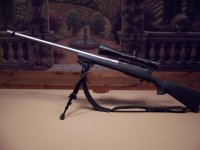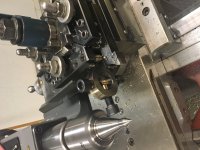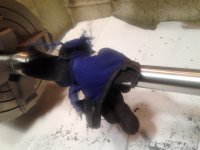You are using an out of date browser. It may not display this or other websites correctly.
You should upgrade or use an alternative browser.
You should upgrade or use an alternative browser.
Barrel Profiling
- Thread starter Curious
- Start date
GeneT
Active member
I use a taper attachment, take light cuts at slow feeds and will hang some 3# lead sinkers from the barrel to reduce vibration if it starts talking to me. This is obviously a long and tedious process and I detest doing it. Pre-contoured barrels are a boon - let the supplier worry about it!
GST
GST
T
tbacala
Guest
Barrel profiling
When I've done it, I would offset the tailstock and use a steady rest about midway on the barrel. When the cutting tool gets close to the steady rest, it is swapped over to the other side. Also, sporter barrels typically have multiple contour angles so the tailstock had to be moved forward for the steeper taper near the chamber. As the cutting is taking place, the tail stock quill has to be monitored to compensate for heat expansion, which can cause the barrel to bow in the center if left unchecked.
Years ago, the NRA put out a gunsmithing book with much more detail on the process. It is an excellent book although now outdated. I think the name of the book was The NRA Gunsmith Guide, and it was a compilation of various articles from the Amercan Rifleman magazine.
When I've done it, I would offset the tailstock and use a steady rest about midway on the barrel. When the cutting tool gets close to the steady rest, it is swapped over to the other side. Also, sporter barrels typically have multiple contour angles so the tailstock had to be moved forward for the steeper taper near the chamber. As the cutting is taking place, the tail stock quill has to be monitored to compensate for heat expansion, which can cause the barrel to bow in the center if left unchecked.
Years ago, the NRA put out a gunsmithing book with much more detail on the process. It is an excellent book although now outdated. I think the name of the book was The NRA Gunsmith Guide, and it was a compilation of various articles from the Amercan Rifleman magazine.
Mike Bryant
Active member
The few that I've profiled, I used a taper attachment and a follower rest that I had modified to have the follower points spring loaded. For the time that it takes to do it and the headaches of doing it, I'd probably just send it back to the manufacturer and have it turned down to the profile that I wanted if they would do it. It all depends upon how valuable your time is. If you are doing it for yourself is one thing, doing it for a customer is another. If you charge by the hour to turn down a barrel, it's not worth the cost.
For all the reasons we know about I would much rather buy the right profile.
Every now and again though the need arrises, sometimes its to reprofile an existing barrel or at the minute I have a heavy straight taper blank that is 1.250" at one end and 1.000" at the other with 4" of parallel at 1.250" - I need to make a medium varmint profile from it.
Usually if I had to turn a barrel from a 1.250" blank I would rough it down in steps working with no more than 12" out of the chuck and using a fixed steady to support things, being a continuos taper it makes this a little more difficult though.
Every now and again though the need arrises, sometimes its to reprofile an existing barrel or at the minute I have a heavy straight taper blank that is 1.250" at one end and 1.000" at the other with 4" of parallel at 1.250" - I need to make a medium varmint profile from it.
Usually if I had to turn a barrel from a 1.250" blank I would rough it down in steps working with no more than 12" out of the chuck and using a fixed steady to support things, being a continuos taper it makes this a little more difficult though.
jackie schmidt
New member
I have turned a few HV profiles down to LV profiles. I use a taper attachment and a steady test.
One important thing is to use a good sharp positive rake tool with just about a zero nose radius, small cuts, and not a lot of RPM.
As Mike said, it's time consuming.
Non CNC barrel profilers use pneumatic following rest that induce just enough pressure to keep chatter down while following the profile.
One important thing is to use a good sharp positive rake tool with just about a zero nose radius, small cuts, and not a lot of RPM.
As Mike said, it's time consuming.
Non CNC barrel profilers use pneumatic following rest that induce just enough pressure to keep chatter down while following the profile.
Can I ask you guys how you profile on non CNC machines?
Are you using a taper turning attachment of some kind and how do you deal with chatter on the slimmer profiles?
I've only re-contoured three barrels, all under duress and all on manual equipment......one was an 1.250 straight blank. They all sucked.
They all paid about $2.00/hr
Here's one that was a "Heavy Palma" with a 3.5" shank, .900 muzzle........it was a prototype, trying to get a 338L, 1.350 Predator action into a Hogue stock so I fitted it, ended up .750 at the muzzle.
This was done WITHOUT a taper attachment. To salvage a blank that was useless to me, and to climb that mountain....
I segmented the barrel into a series of (34?-35?) flats of various lengths and diameters and then stuck her into travel mode and hand-fed the crossfeed to wipe out the steps.
Just connected the dots, by hand.


What I meant to say was, the shank was 3.5" long and a custom-ordered 1.350 diameter to start......I turned the taper 'inside-out' to look like the old Win70 ultralite.....still a pretty heavy Krieger bbl but the rifle came in at 8lb. It's built around the new 280gr Barnes and has 70+lb recoil energy....It'd break your collarbone without the brake. With the brake it's a pussycat, about like a 308 w/150's and makes a roundish hole.....a complete success
Last edited:
cloudrepair
DWG
I offset my tailstock and use a high feed rate with slow speed about 170 rpm to 300 rpm till I am almost to finish size then slow rpm down to 120 to 70 rpm and slow the feed rate back down maybe 5 ipm for the finish pass. Through the whole process I follow the tool post with a 2pound piece of oil impregnated bronze resting on the barrel holding it there in my hand. For the harmonics dampening. Other tapers I do with the compound.
Then I clean it up with a file at slow speeds then emery cloth.
It takes a few hours. not something I look foward to
Then I clean it up with a file at slow speeds then emery cloth.
It takes a few hours. not something I look foward to
Last edited:
B.Larson
New member
I use a taper attachment, take light cuts at slow feeds and will hang some 3# lead sinkers from the barrel to reduce vibration if it starts talking to me. This is obviously a long and tedious process and I detest doing it. Pre-contoured barrels are a boon - let the supplier worry about it!
GST
+2
I often duplicate existing barrels or make custom contours so it is a necessity for me to be able to profile barrels and in the future I hope to have a hydraulic tracer set up to make things a little easier. With that in mind a made up a simple follow rest to see how it well it works and low and behold it works very well! in fact it will probably be what I use with the tracer. I think the picture speaks for itself the tips are spring loaded I was going to put a tip in the back but decided against it for the prototype to make it a little easier to mount. The way I have the follower mounted it wouldn't work for everyone but any similar method of attachment could be used. I use my compound to profile since I set many different tapers, often two to three per a given barrel and it makes it faster to set up. The test barrel was .650 muzzle diameter which is on the large side for my sporter rifles but it cut with absolutely no chatter.
Attachments
Last edited:
cloudrepair
DWG
Nice follow rest ndh78
martin zuck
Member
Can I ask you guys how you profile on non CNC machines?
Are you using a taper turning attachment of some kind and how do you deal with chatter on the slimmer profiles?[/QUOTE
Broke my left femur a while back so I have plenty of time on my hands!
In the past have tapered a good number of barrels on either of my H10's. I run the lathe in high back gear using a sharp positive rake high speed steel tool. I run a fairly fast .009 feed starting at the muzzle(tail stock) taking .015-.020 per side for a distance of 5.-6. inches using a steady rest as I go. Forgot to mention I have a taper attachment on both machines. It is IMPORTANT to readjust the tail stock as you go unless you have coolant. I do the cutting dry.
The last barrel I cut down was a light varmint that my daughter shot a .186 100yd. agg. at Kane, Pa.
P.S.
Sometimes I will wrap a rag around the barrel while holding on to it to eliminate any slight chatter.
Doug Kennedy
Hemi Road Runner
Years ago I used a crankshaft grinder. I put a live center in the Chuck on the tail stock and locked the Chuck so it wouldn't rotate. I would adjust the cross-slide to get the taper I wanted. I was lucky my grinder had a table traverse. Not all crank grinders had a table traverse.
A
Alan Warner
Guest
For what it may be worth.
I've done more than I care to count and sending it to the barrel maker is always a better idea but not always feasible
given time constraints, etc.
I hang the whole barrel with a dummy center in the muzzle end and drive from the 3" or so at the chamber end in the chuck.
First, cut a few spots down the line for the steady rest and have at it. I cut in length increments of either 1/2" or whole inch
steps -- small end to large, moving the steady as needed. Some heavy to light need two passes, but most are done in one
string. Plenty of water sol coolant, generous radius on the tool. .004 to .006 per rev., 500 to 750 RPM.
the trick for me is to not try to skimp on the number of steady positions. One about every 6" (or a little less) usually works well. barrel stays cool
The point of needed attention is the steady--- keep a close eye out for heat and use plenty of lube. NOT tight, just steadied.
Always better to take .020 or more that trying to take .005-.010
Off to a junker lathe ( with the ways covered up well) to belt sand out the steps, emery 400 and Mothers.
Averages about 3 hours and done only if the customer is willing to pay my rate . Works slick, nice and even.
Alan.
Alan
I've done more than I care to count and sending it to the barrel maker is always a better idea but not always feasible
given time constraints, etc.
I hang the whole barrel with a dummy center in the muzzle end and drive from the 3" or so at the chamber end in the chuck.
First, cut a few spots down the line for the steady rest and have at it. I cut in length increments of either 1/2" or whole inch
steps -- small end to large, moving the steady as needed. Some heavy to light need two passes, but most are done in one
string. Plenty of water sol coolant, generous radius on the tool. .004 to .006 per rev., 500 to 750 RPM.
the trick for me is to not try to skimp on the number of steady positions. One about every 6" (or a little less) usually works well. barrel stays cool
The point of needed attention is the steady--- keep a close eye out for heat and use plenty of lube. NOT tight, just steadied.
Always better to take .020 or more that trying to take .005-.010
Off to a junker lathe ( with the ways covered up well) to belt sand out the steps, emery 400 and Mothers.
Averages about 3 hours and done only if the customer is willing to pay my rate . Works slick, nice and even.
Alan.
Alan
Can I ask you guys how you profile on non CNC machines?
Are you using a taper turning attachment of some kind and how do you deal with chatter on the slimmer profiles?[/QUOTE
Broke my left femur a while back so I have plenty of time on my hands!
In the past have tapered a good number of barrels on either of my H10's. I run the lathe in high back gear using a sharp positive rake high speed steel tool. I run a fairly fast .009 feed starting at the muzzle(tail stock) taking .015-.020 per side for a distance of 5.-6. inches using a steady rest as I go. Forgot to mention I have a taper attachment on both machines. It is IMPORTANT to readjust the tail stock as you go unless you have coolant. I do the cutting dry.
The last barrel I cut down was a light varmint that my daughter shot a .186 100yd. agg. at Kane, Pa.
P.S.
Sometimes I will wrap a rag around the barrel while holding on to it to eliminate any slight chatter.
Be careful with that rag please. I nearly lost a thumb, (hand, arm? Life??) because I put a cloth glove on while contouring the barrel in my picture.

martin zuck
Member
Be careful with that rag please. I nearly lost a thumb, (hand, arm? Life??) because I put a cloth glove on while contouring the barrel in my picture.
View attachment 18299
View attachment 18300
Point well taken! That is why I use a small rag so I can leave go of it in a hurry!
Bill Leeper
New member
When I started out, we bought all our barrels as 1 1/4 blanks and contoured them to whatever (barrels were mostly from Shilen, Hart, and Douglas). Even now, I frequently re-contour to acheive proper balance or a certain look. I turn between centers, driving the barrel with a dog. I use a copier or offset the tailstock depending on my mood and what I am trying to accomplish. I use what might best be described as a modified chip-breaker tool with a very sharp cutting edge and set it slightly above center.
I can't say how many barrels I have contoured or re-contoured but certainly hundreds. I have found that chattering sometimes occurs for no apparent reason and, occasionally, I have some trouble sorting it out but usually it works out ok.
Still and all, those who recommend just buying the right contour in the first place are offering good advice. I re-contour because I can cut exactly what I want and can get it done today. Re-contouring a barrel takes about an hour or a little less. Regards, Bill.
I can't say how many barrels I have contoured or re-contoured but certainly hundreds. I have found that chattering sometimes occurs for no apparent reason and, occasionally, I have some trouble sorting it out but usually it works out ok.
Still and all, those who recommend just buying the right contour in the first place are offering good advice. I re-contour because I can cut exactly what I want and can get it done today. Re-contouring a barrel takes about an hour or a little less. Regards, Bill.



